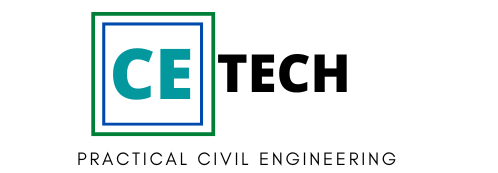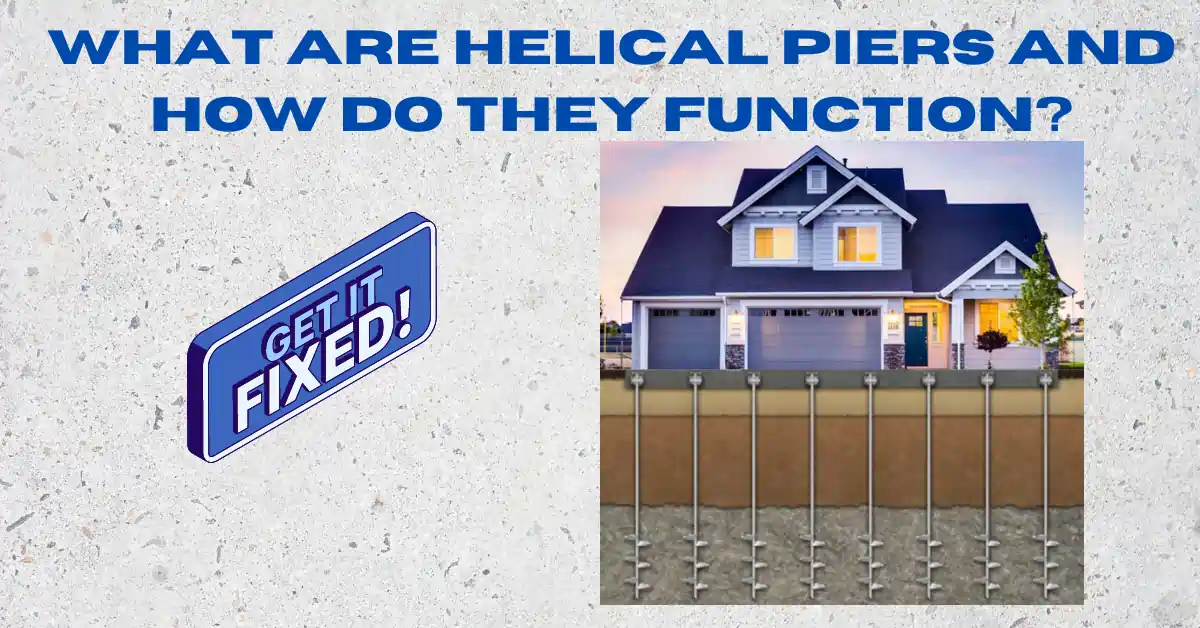Helical piers are innovative foundation support systems that have been commonly used in various geotechnical and foundation projects. Their wide application is because of their versatility, high loading capacity, and that they can be installed with minimum disruption, easily and without generating spoils. The helical pile system can be employed in the repair and renovation industry as well as in new construction. We will look at the technical characteristics and application of helical piers in the following discussion.

Helical piers, also known as helical piles or screw piles, are innovative foundation support systems that are used in construction and retrofit projects. The use dates back 200 years. In 1830 they were used for the first time. After waning of their use for some time opting for a more developed deep foundation, their use surged again after the 2nd half of the 20th century where they found application for in-tension structures such as guying towers and poles. Today they are used in both tension and compression loading and have become widely accepted because of their versatility and the use of minimal equipment.
Helical piers consist of a central steel shaft with helical plates or “screws” attached to it. The steel shafts typically are either sections of solid square bars or hollow round tubes or pipes. Main sections or extensions with or without helices constitute a typical helical pier. The main sections are generally 5- 10 feet long. Extensions are generally 3-10 feet long.
A coupler is used to join the helix section together. The coupler is bolted to connect the pier sections. The difference with push piers is that the coupler of push pier sections are not bolted connections but are slip-fit connections.
These helical plates are similar to the threads on a screw and are used to “screw” the pier into the ground. This unique design allows helical piers to be installed with minimal disruption to the surrounding environment.
The installation process involves driving the helical piers into the ground using hydraulic machinery or other specialized equipment. As the piers are screwed into the soil, they create a solid and secure foundation by transferring the load of the structure onto more profound, more stable layers of soil or bedrock. This can help prevent settling, shifting, or structural damage that can occur due to unstable soil conditions.
Helical piers are versatile and can be used for a variety of applications, including residential, commercial, and industrial projects. Their suitability for various cases of soil comes from the adaptability of the pier sections by changing the number and area of helical pier blades or helices.
By varying the configuration the bearing capacity can be adjusted to a wide range of soil conditions. Helical piers work by the bearing capacity developed by the area of the blades or helices as well as by the end bearing of the pier.
how do helical piers work
Helical piers consist of a central shaft with helical-shaped plates (similar to a large screw) attached to it. Like push piers, the weight of the structure is not required to drive the piers into the ground. Therefore, helical piers are preferred for light structures in cases where push piers are not a good option. The blades multiply the load-carrying capacity so are suitable for supporting heavy loads.

The load-carrying capacity is derived from the bearing area of the helices or blades. However, the end-bearing resistance also accounts for a minimal increase in capacity.
After a load of existing load to be supported is determined, the target load carrying capacity after multiplying with a factor of safety is calculated. The torque that is applied in driving is related to the load-carrying capacity, thus the torque is applied until the target load-carrying capacity is reached. Hence, the installation is performed with immediate load testing.
Helical piers transfer the loads directly to brackets that are fixed under the footings. The brackets are fixed on the side or directly concentrically under the footing. The piers function by transferring the load from the existing building to the brackets and through the piers to the stable soil stratum.
Helical piles have limitations in generating high lateral capacities due to their slender shafts, requiring additional structural solutions for lateral loads.
They are commonly used for supporting structures like decks, foundations, retaining walls, towers, and even utility poles. Their ability to provide strong and reliable foundation support in a wide range of soil conditions has made them a popular choice in modern construction and engineering practices.
As the helical pier penetrates deeper into the soil, the helical plates create a helical bearing zone. This zone distributes the load of the structure evenly across a larger area of soil, reducing the risk of settling or sinking. Much of the load-bearing comes from the bearing area of the helices. However, some end-bearing load capacity can be achieved.
The helical plates provide significant resistance against uplift forces. This is especially valuable in regions prone to high winds or areas where the water table can cause the foundation to lift.
Helical piers can reach stable soil layers or bedrock, ensuring a solid foundation for the structure. This stability minimizes the risk of foundation settlement and structural damage.
Unlike traditional concrete footings that require curing time, helical piers provide immediate load-bearing capacity. This means that construction or renovations can continue shortly after installation.
The purpose of their use can be for strengthening settling foundations or supporting additional loads due to building renovations. They are used also in new constructions.
Helical piles technical properties and requirements
Helical piles can be tailored to meet specific design requirements, including helix plate configurations and shaft sizes for various soil conditions. Foundation support works products are manufactured as Special “V-style” helix plates, thicker helix plates, and spiral-cut lead shaft tips for better penetrating and/or bearing in dense soils.
During the installation, the load-carrying capacity is calculated from well established Torque-to-Capacity relationship. Hence, the applied torque is related to the load-carrying target capacity through correction factors. The correction factors are established from years of testing allowing for accurate capacity calculations. Torque-to-capacity ratios are listed in ICC-ES AC358 for conforming products
The load-carrying capacity can be calculated also using standard soil mechanics bearing calculations. The bearing capacity for each blade is calculated and summed up with the end bearing capacity to arrive at the total bearing capacity of the piles. The other practical load-carrying capacity estimation is performed directly as direct load testing of the piles under installation.
However, despite their versatility, they are not suitable for very loose or soft soils as well as hard rocks. Helical piles will not typically penetrate hard rock, defined by auger refusal by the drill rig or SPT N-values ≥ 50 blows/6 inches of sampler penetration (ASTM D1586)
Helical piles may penetrate into hard clay, dense sand, and soft or weathered bedrock; however, larger installation equipment is generally recommended to provide a “crowd” or axial force on the pile during advancement into these soils.
Pros and cons of helical piers
Pros of Using Helical Piles in Construction:
Versatility: Helical piers can be used in a wide range of soil conditions, making them suitable for both residential and commercial applications. They are effective in stabilizing foundations, retaining walls, and other structures.
Ease of Installation: These piers are relatively easy to install, requiring minimal excavation and disturbance to the surrounding area. They are typically screwed into the ground using hydraulic machinery, reducing the need for extensive digging.
Immediate Load-Bearing Capacity: Once installed, helical piers can bear loads immediately. This is particularly advantageous in projects where time is a critical factor, as it eliminates the need to wait for concrete to cure.
Minimal Site Disruption: Compared to traditional concrete piers, helical piers generate less debris and disruption during installation. This can be especially beneficial in projects where preserving the landscape or minimizing disruption to nearby structures is important.
Adaptable for Limited Access Areas: Helical piers can be used in areas with limited access, as the equipment required for installation is compact and maneuverable. This makes them a practical choice for retrofitting existing structures.
High Capacity Alternative: Helical piles offer high load-bearing capacities, up to 100
Kips or 45 tons may be achieved with helical shaft sizes of 4.5 inches even with relatively small shaft sizes, making them suitable for deep foundation applications.
Predictable Capacity: With proper soil information and design expertise, helical pile capacities can be accurately estimated without extensive load testing.
All-Weather Installation: Helical piles can be installed in challenging weather conditions, including freezing temperatures. But push piers can not be installed in extreme weather situations heavy rain, snow, or sub-zero temperature.
Quick and Versatile Installation Methods: They can be quickly installed using a variety of equipment, including hand-held tools and mini-excavators, suitable for projects with limited access.
Economical Mobilization: Helical piles require smaller equipment, leading to lower mobilization costs compared to other deep foundation systems.
Vibration-Free Installation: Installation of helical piles does not cause ground vibrations, in contrast to traditional driven piles.
Minimal Spoils Generation: Helical piles do not bring soils to the surface during installation, reducing the need for soil disposal and minimizing costs. Helical piles do not auger soils to the surface. Therefore, there are no haul-off or disposal costs for spoils similar to auger-cast piles or drilled shafts. For contaminated sites, disposal and/or treatment of disturbed material can be extremely costly or make the project cost-prohibitive. Helical piles simply pass through contaminated soils and do not bring them to the surface.
Support for Temporary Structures: Helical piles can be easily removed from the ground if needed, allowing for flexibility in temporary construction.
Immediate Load Testing: Load tests can be conducted shortly after installation, without the need for curing periods common in other foundation methods.
Immediate Concrete Pouring: Following helical pile installation, concrete can be poured immediately for timely project progress.
Clean Installation: Helical pile installation doesn’t involve concrete or grout, leading to a cleaner construction site.
Cons and Limitations of Using Helical Piles:
Cost: Helical piers can be more expensive upfront than some traditional foundation methods. However, they may offer cost savings in the long term due to reduced labor and installation time.
Soil Variability: While helical piers are versatile, their effectiveness can vary depending on the soil type. In some cases, the load-bearing capacity might be reduced if the soil conditions are extremely soft or loose, expansive or shifting soils.
Not Ideal for Extremely Heavy Loads: While helical piers can handle a significant amount of weight, they may not be the best choice for extremely heavy structures or loads. In such cases, alternative foundation methods might be more suitable.
Limited Depth: The depth to which helical piers can be installed is limited by the soil’s load-bearing capacity. If deeper penetration is required, a different foundation solution might be necessary.
Not Universally Suited: Helical piles might not be the best option for all projects or soil profiles, as other foundation alternatives have their own advantages and limitations.
Corrosion Concerns: In corrosive soil environments, proper protection measures are needed to prevent the degradation of the steel components.
Challenging Materials: Helical piles may struggle with dense debris, wood, gravelly soils, or large soil fractions, requiring additional measures for installation.
Overall, helical piles offer various benefits including versatility, cost-efficiency, and ease of installation, but their effectiveness depends on the specific project conditions and soil profiles.

